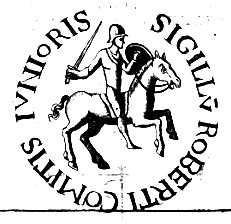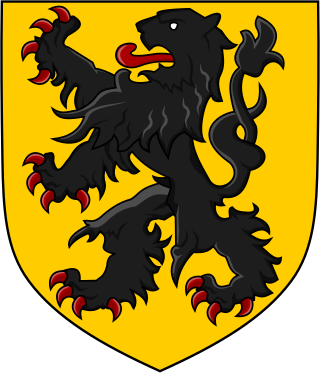Related Research Articles

The First Crusade (1096–1099) was the first of a series of religious wars, or Crusades, initiated, supported and at times directed by the Latin Church in the Middle Ages. The objective was the recovery of the Holy Land from Islamic rule. While Jerusalem had been under Muslim rule for hundreds of years, by the 11th century the Seljuk takeover of the region threatened local Christian populations, pilgrimages from the West, and the Byzantine Empire itself. The earliest initiative for the First Crusade began in 1095 when Byzantine emperor Alexios I Komnenos requested military support from the Council of Piacenza in the empire's conflict with the Seljuk-led Turks. This was followed later in the year by the Council of Clermont, during which Pope Urban II supported the Byzantine request for military assistance and also urged faithful Christians to undertake an armed pilgrimage to Jerusalem.

Theoderic, commonly known as Thierry of Alsace, was the fifteenth count of Flanders from 1128 to 1168. With a record of four campaigns in the Levant and Africa, he had a rare and distinguished record of commitment to crusading.

Robert II, Count of Flanders was Count of Flanders from 1093 to 1111. He became known as Robert of Jerusalem or Robert the Crusader after his exploits in the First Crusade.

Charles the Good was Count of Flanders from 1119 to 1127. His murder and its aftermath were chronicled by Galbert of Bruges. He was beatified by Pope Leo XIII in 1882 through cultusconfirmation.
Baldwin II (1056–1098?) was count of Hainaut from 1071 to his death. He was an unsuccessful claimant to the County of Flanders. He disappeared in Anatolia during the First Crusade.

Barisan of Ibelin was an important figure in the crusader Kingdom of Jerusalem, and was the founder of the Ibelin family. His name was later written as "Balian" and he is sometimes known as Balian the Elder, Barisan the Old or Balian I. Barisan was lord of Ramla from 1138 to 1150.
Roman of Le Puy, also known as Romanus of Puy, was the first lord of Oultrejordain in the Kingdom of Jerusalem from around 1120 to around 1126. He was a nobleman from Auvergne who accompanied Adhemar de Monteil, Bishop of Le Puy, to the Holy Land during the First Crusade. He signed royal charters during the reign of Baldwin I of Jerusalem. Baldwin I or his successor, Baldwin II of Jerusalem, granted Roman the important fief of Oultrejordain, or its northern region. He was deprived of most of his domains because of a rebellion against Baldwin II. He and his son lost their remaining estates after they were accused of conspiring against Baldwin II's successor, Fulk of Anjou, in the early 1130s.
Héribrand III of Hierges(Héribrand of Bouillon) was lord of Hierges and Castellan of Bouillon. He was the son of Héribrand II of Saussure, lord of Hierges and of Hedwige d'Orchimont.

The House of Flanders, also called the Baldwins, was a medieval ruling family of Frankish origin that was founded by Baldwin Iron Arm, son-in-law of Charles the Bald. The House of Flanders was the first dynasty to transform a county function of the Carolingian Empire into a hereditary fiefdom, the County of Flanders, falling under West Francia, created by the Treaty of Verdun in 843.

The role of women in the Crusades is frequently viewed as being limited to domestic or illicit activities during the Crusades. While to some extent this is true, some women also took part in other activities, including armed combat in the battles of the Holy Land. This article focuses on the first Crusades and identifies known participants. It also highlights some of the more famous women of the later crusades. For a discussion of the sociological and religious aspects of the mixing of women with the predominantly male crusaders, the reader is referred to the referenced documents.
The army of Hugh the Great was formed after the Council of Clermont, led by Pope Urban II in November 1095. Hugh, son of Henry I of France, and his wife Anne of Kiev, was Count of Vermandois, de jure uxoris, due to his marriage to Adelaide of Vermandois. In August 1096, Hugh and his small army left France in prima profectione, the first army of the third wave to leave France, and travelled to Bari, Italy, and then crossed the Adriatic Sea to the Byzantine Empire, in an armada commanded by Arnout II, Count of Aarschot. When Hugh entered Constantinople, he carried a Vexillum sancti Petri, a banner given to him by the pope, Hugh being the last such noble to carry the banner.
The army of Godfrey of Bouillon, the duke of Lower Lorraine, in response to the call by Pope Urban II to both liberate Jerusalem from Muslim forces and protect the Byzantine Empire from similar attacks. Godfrey and his army, one of several Frankish forces deployed during the First Crusade, was among the first to arrive in Constantinople. The army was unique in that it included among its warriors the first three kings of Jerusalem, although Godfrey preferred the title Defender of the Holy Sepulchre, Advocatus Sancti Sepulchri, as he believed that the true King of Jerusalem was Christ. This article focuses on the members of the army rather that its exploits which are described in detail in Godfrey’s biography as well as numerous sources listed below.
The army of Raymond of Saint-Gilles was one of the first to be formed after Pope Urban II called for the First Crusade. Raymond formed a Provençal army and left his County of Toulouse in October 1096, traveling over the land route. He was the only leader of a major army that did not swear an oath of fealty to Byzantine emperor Alexius I Komnenos.
The armies of Bohemond of Taranto, formed in 1097, include a major component of the First Crusade. He is regarded as the real leader of the First Crusade. He formed a second army in 1107 to defend Antioch but instead used it to attack the Byzantine emperor Alexios I Komnenos, resulting in the Treaty of Devol, codifying Bohemond’s defeat. Runciman estimates that the first army included 500 cavalry and 3500 infantrymen and other estimates that the second army was at 34,000 personnel strength are likely greatly exaggerated.
The sacred relic of Saint George was one of the most famous of relics, after the True Cross and Holy Lance, and was the arm of the Saint George, ordered killed by the Roman Emperor Diocletian for his failure to renounce his faith in Christ. George, a secondary patron saint of the First Crusade, played a significant role and provided other relics, as the occupation of his tomb at Lydda marked the first Latin bishop of Jerusalem as well as a service to ask for his intervention. The arm was given to the abbey of Anchin by Robert of Jerusalem at some time during the Jerusalem campaign.
The army of Robert Curthose, Duke of Normandy, left for the Holy Land on the First Crusade. Robert was the eldest son of William the Conqueror and brother to William Rufus, king of England. He was reportedly so poor that he often had to stay in bed for lack of clothes. In order to raise money for the crusade he mortgaged his duchy to his brother William II of England. His army joined the contingent of Robert II, Count of Flanders, and Stephen, Count of Blois.
The armies of Count Stephen of Blois participated in both the First Crusade of 1096 and the Crusade of 1101. Stephen apparently fled the battlefield at the Siege of Antioch and returned home. He was coerced by his wife, Adela of Normandy, to form another army to return to the Holy Land in 1101, accompanied by Count Stephen I of Burgundy.
Baldwin Chauderon was a knight from Berry who was killed during the siege of Nicaea. It is unclear whether or not he belonged to any of the major armies of the First Crusade.
The following is an overview of the armies of First Crusade, including the armies of the European noblemen of the "Princes' Crusade", the Byzantine army, a number of Independent crusaders as well as the People's Crusade and the subsequent Crusade of 1101 and other European campaigns prior to the Second Crusade beginning in 1147.
The Crusade of 1129 or the Damascus Crusade was a military campaign of the Kingdom of Jerusalem with forces from the other crusader states and from western Europe against the Emirate of Damascus. The brainchild of King Baldwin II of Jerusalem, the crusade failed to meet its military objectives. Its diplomatic preliminaries, however, secured the succession to the throne of Jerusalem and papal backing for the Knights Templar.
References
- ↑ Runciman, S. (1949). The First Crusaders' Journey across the Balkan Peninsula. Byzantion, 19, 207–221.
- ↑ "A Database of Crusaders to the Holy Land: The Army of Robert II".
- ↑ Riley-Smith, Jonathan. The First Crusaders: 1095–1131.
- ↑ Riley-Smith, Jonathan. The First Crusaders. pp. 99, 204.
- ↑ Riley-Smith, Jonathan. The First Crusaders. pp. 141, fn 238.
- ↑ Winrich of Flanders. A Database of Crusaders to the Holy Land, 1095–1149.
- ↑ Riley-Smith, Jonathan. The First Crusaders. pp. 87, note 36, pg 141, note 238.
- ↑ Riley-Smith, Jonathan. The First Crusaders. pp. 87, note 36.
- ↑ Riley-Smith, Jonathan. The First Crusaders. pp. 87, note 36.
- ↑ Riley-Smith, Jonathan. The First Crusaders. p. 151.
- ↑ Riley-Smith, Jonathan. The First Crusaders. pp. 63–65, 74, 122–3.
- ↑ Gilbert of Bruges. See Sources. pp. 58, fn 172.
- ↑ Riley-Smith, Jonathan. The First Crusaders. pp. 19, 219.
- ↑ Riley-Smith, Jonathan. The First Crusaders. p. 120.
- ↑ Riley-Smith, Jonathan. The First Crusaders. pp. 86, 151–2, 208.
- ↑ Riley-Smith, Jonathan (April 2003). The First Crusade and the Idea of Crusading. ISBN 9780826484314.
- ↑ Riley-Smith, Jonathan. The First Crusaders. pp. 141, note 238.